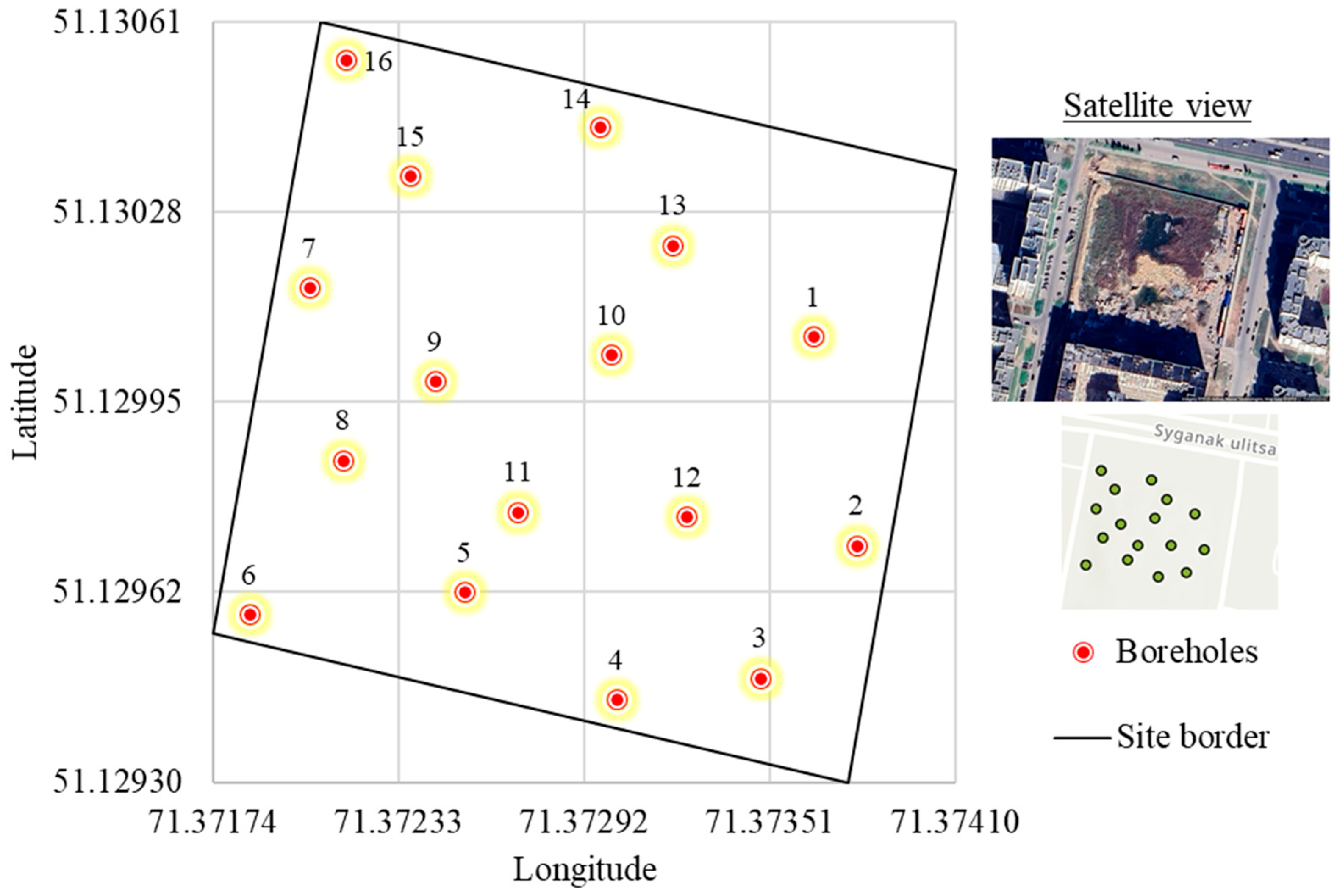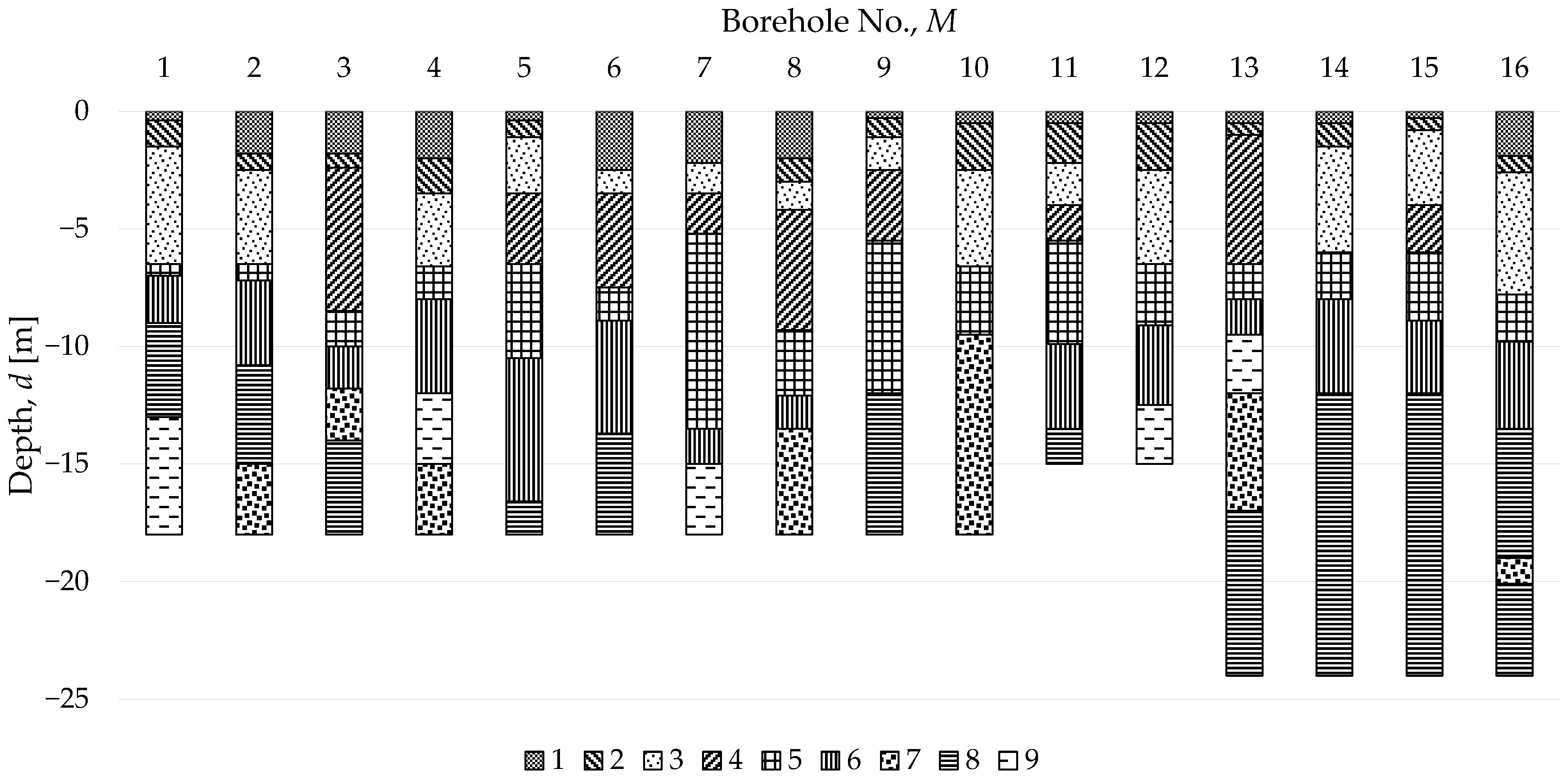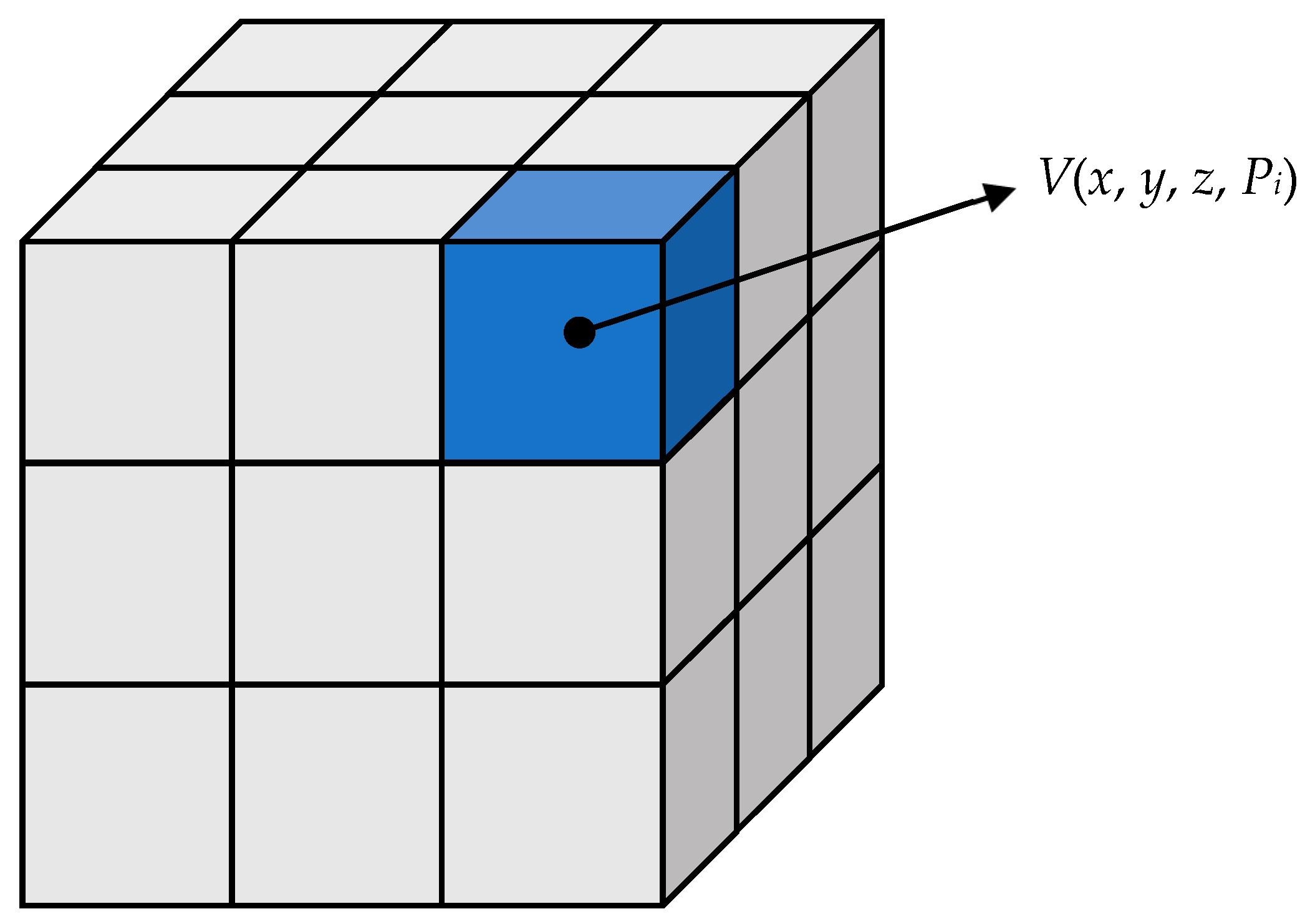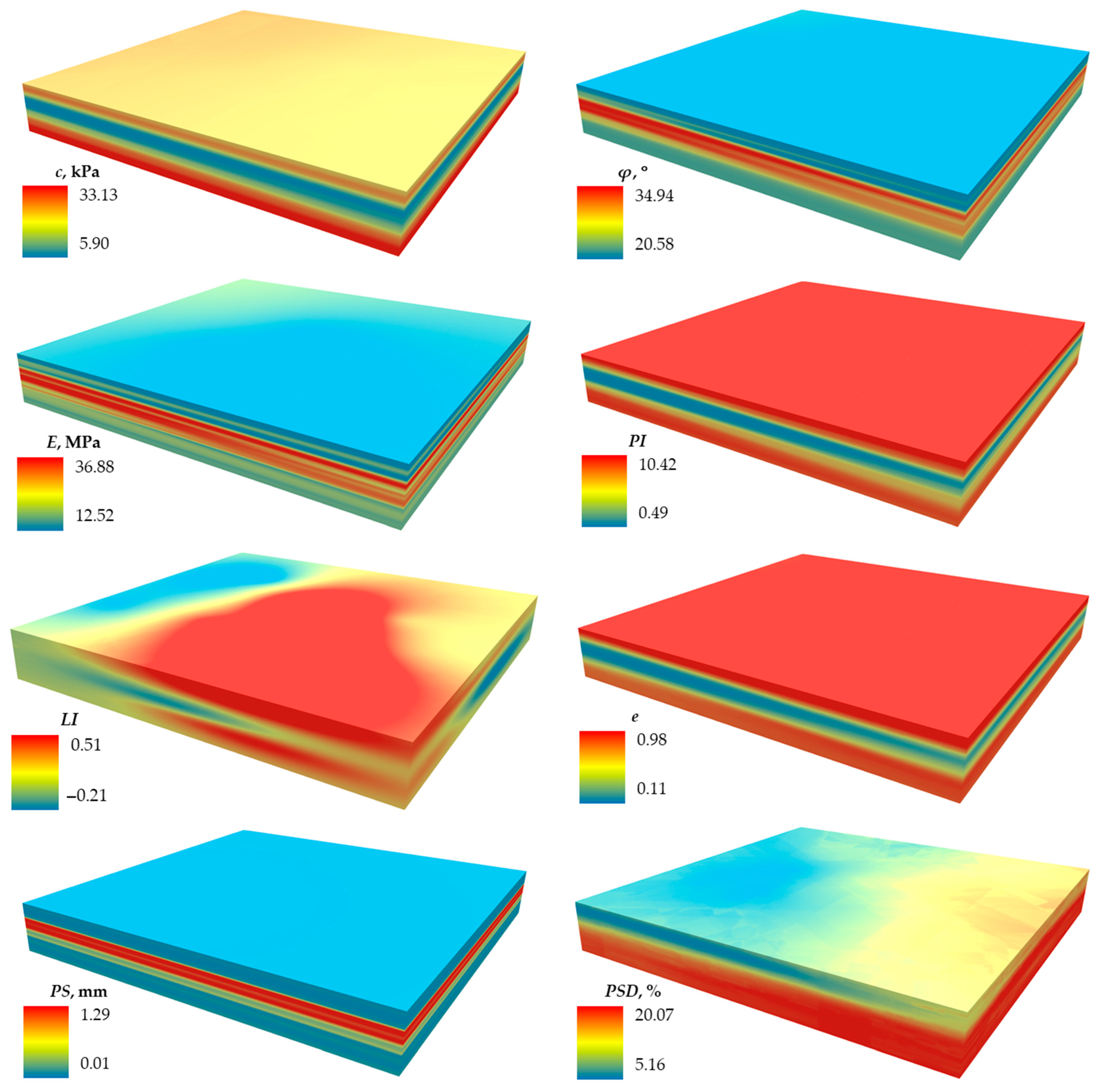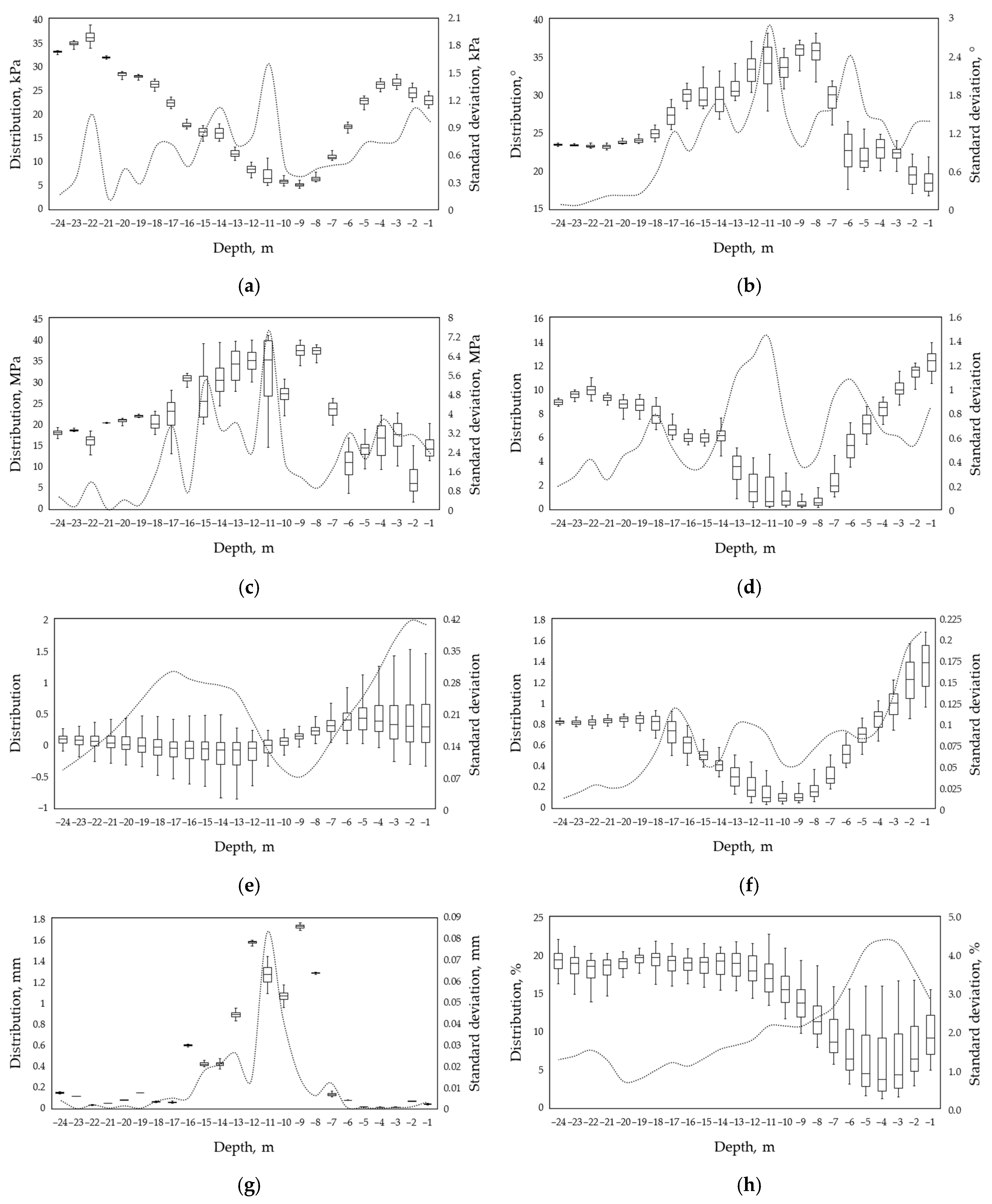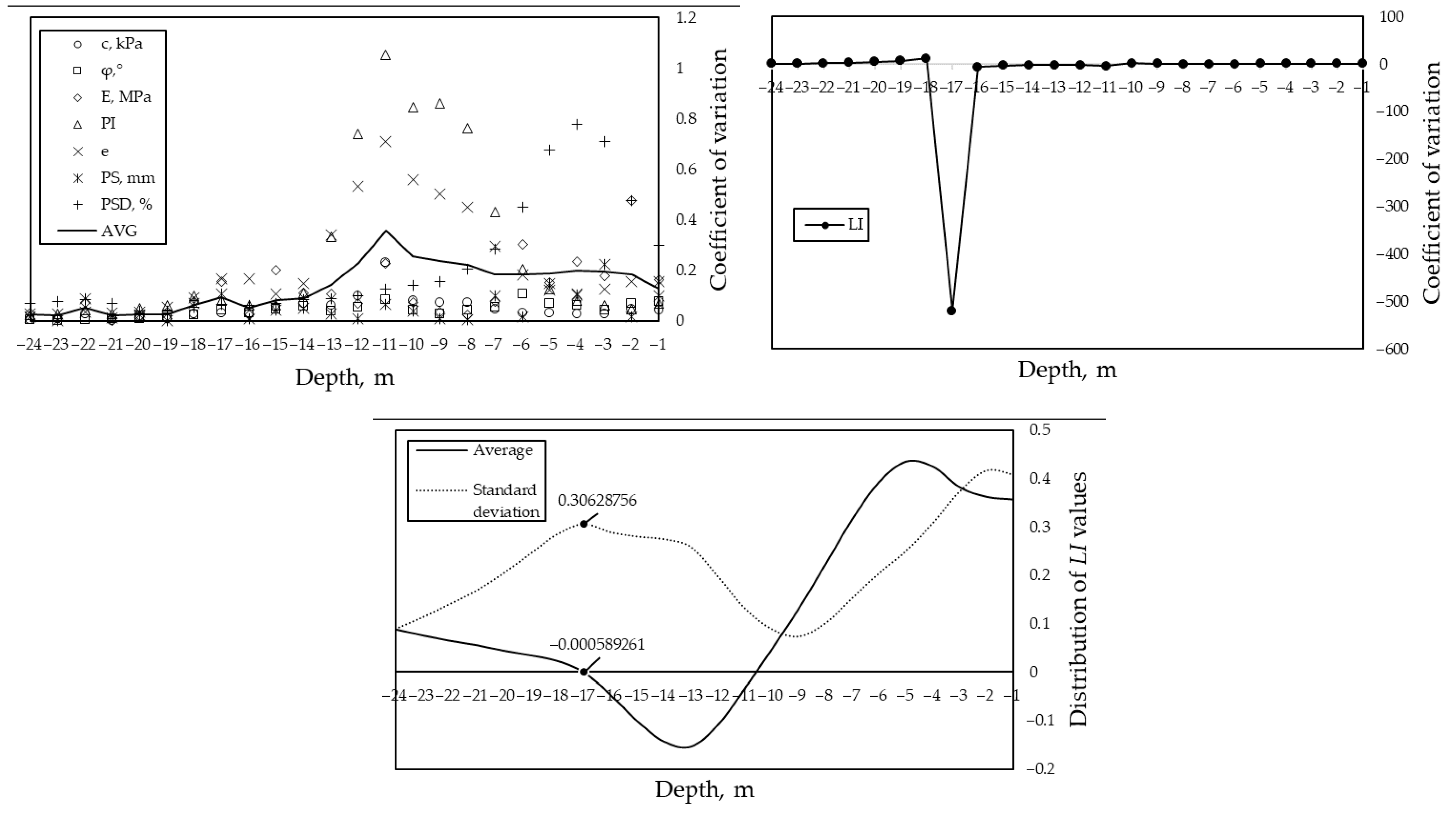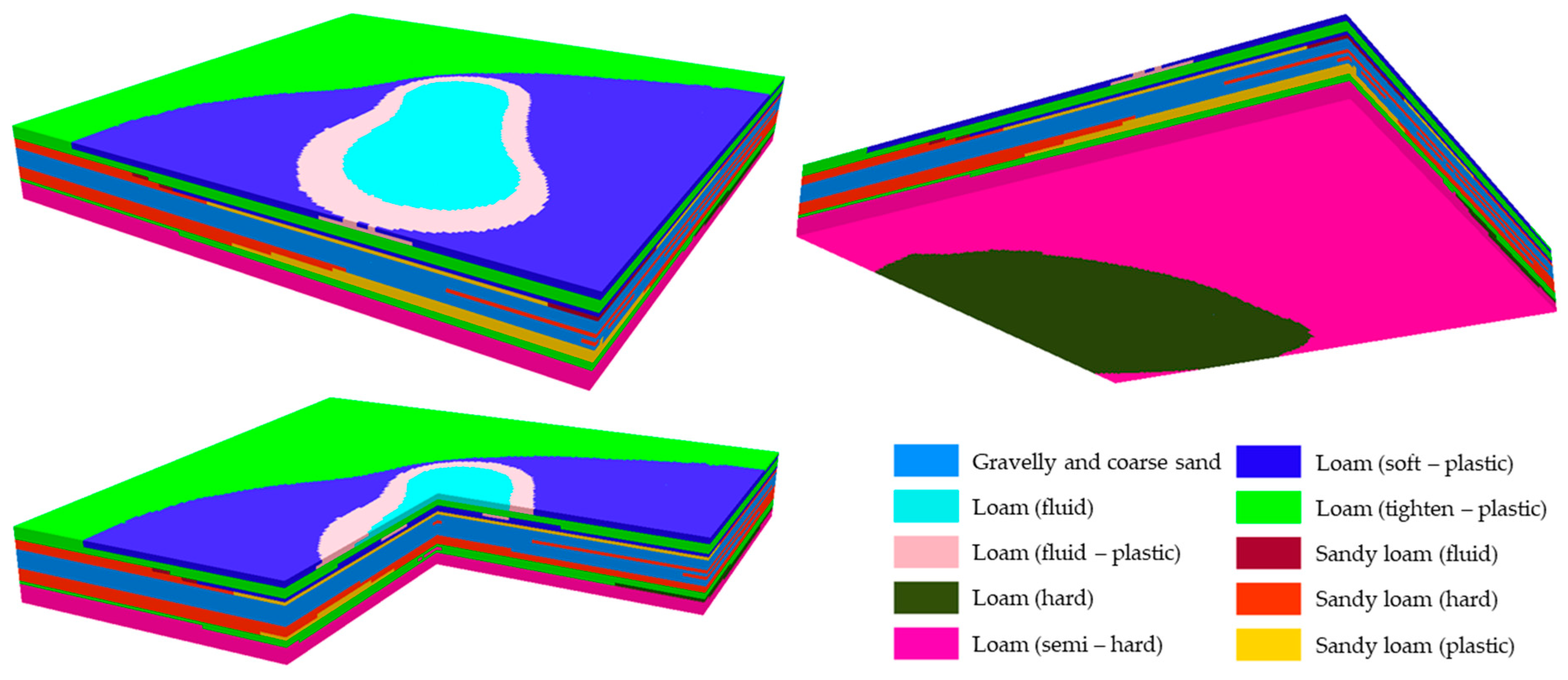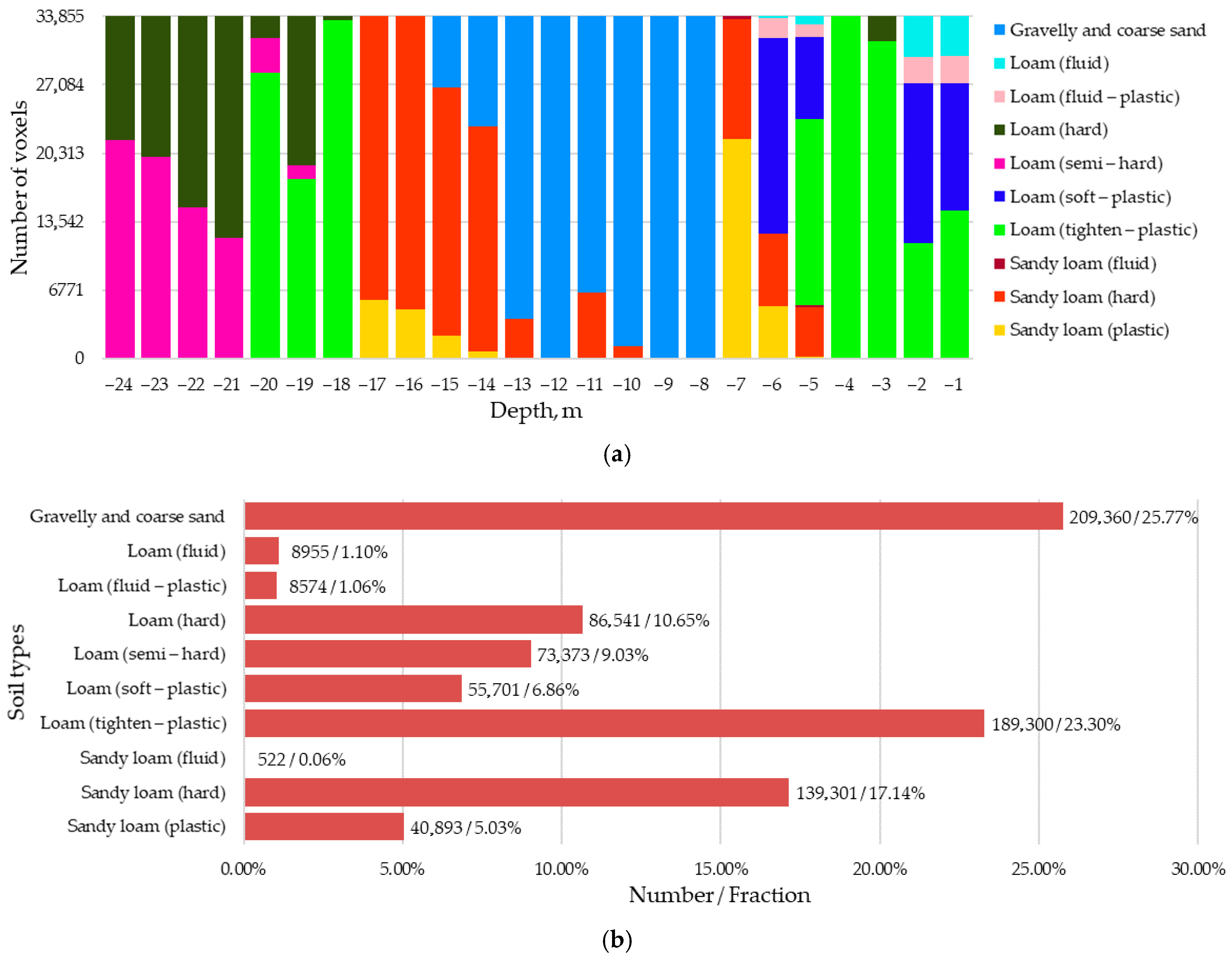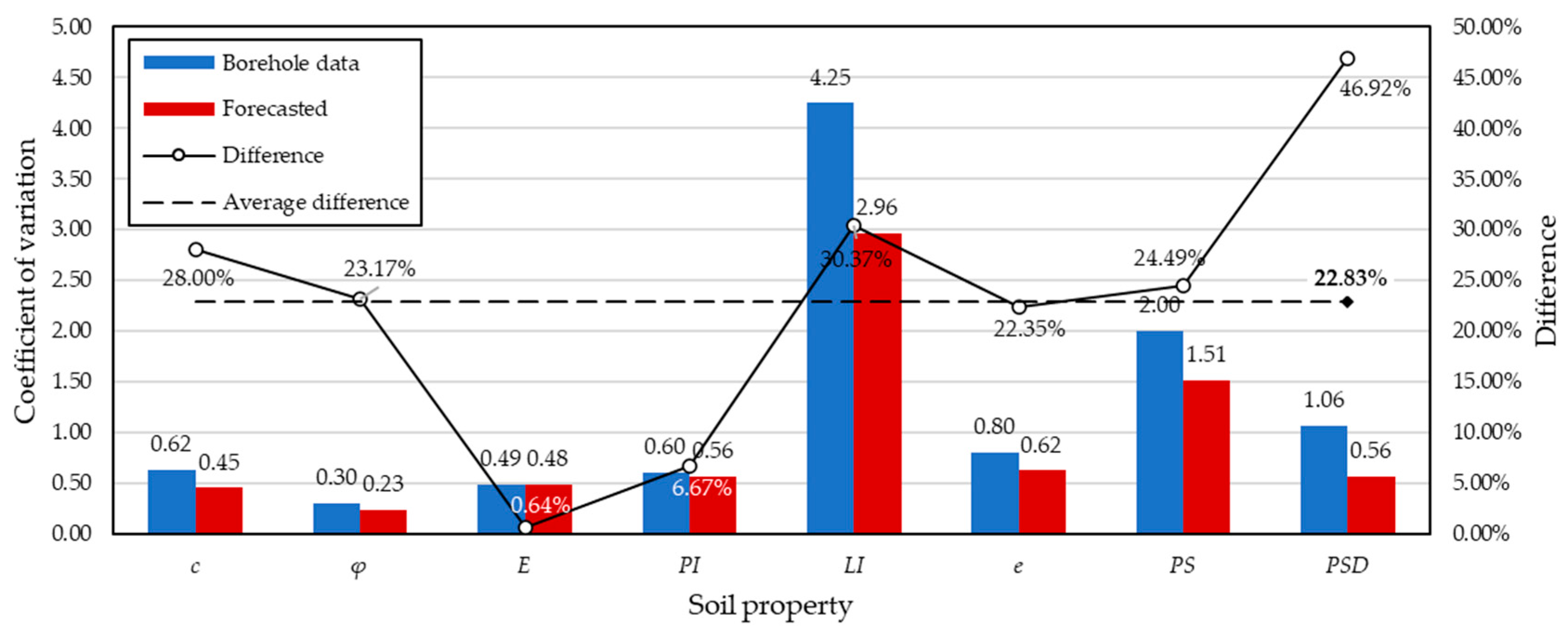1. Introduction
The basis of information on soils is an engineering–geological report containing data obtained in field and laboratory conditions, including testing of samples [
1]. Subsequently, these data are used to assess the bearing capacity of the base [
2]. Geotechnical surveys often provide discrete property values from sparse borehole data, which may fail to capture subsurface variability [
3,
4]. When data are needed at unknown locations between boreholes [
3], geotechnical engineers and designers rely on the recommendations of regulations that specify soil properties for an idealized state [
5]. In areas with complex lithology, such as clayey soils in Astana (Kazakhstan), traditional reliance on normative tables can lead to oversimplification and design uncertainty, failing to reflect local variability critical for structural safety [
6,
7].
Current solutions [
8] for automated estimates are based on 2D or 3D modeling and finite element calculations, where the input data are empirical parameters from a geotechnical report [
9]. The amount of input data contributes to the realism of the base model and the reliability of the results of the calculation of its bearing capacity [
10,
11].
In recent decades, the need for a more complete picture of soil occurrence and its physical and mechanical characteristics has increased significantly, as accidents in buildings and facilities related to base settlement and waterlogging have become more frequent [
12,
13]. This has contributed to unlocking the potential of alternative techniques and tools to represent the geological structure and spatial distribution of soil properties [
14]. The latter has been widely applied in soil science. Soil maps and digital elevation models are created using Geographic Information Systems (GISs) [
15]. The model using these units assumes that the mapped soil property is homogeneous within a certain zoned classification, and changes occur only outside the zone, which is not quite similar to the natural pattern of occurrence [
16], since it should be taken into account that soil properties have a continuous character of distribution, and though smoothly, they do change in space [
17]. Although widely used [
18,
19,
20,
21,
22,
23,
24,
25,
26,
27,
28,
29,
30], traditional 2D interpolation methods like Kriging, IDW, Topo to Raster, Natural Neighbor, and Spline often fail to capture vertical continuity and complex soil stratigraphy [
31,
32,
33,
34]. More accurate distribution requires 3D interpolation based on non-traditional primitives such as voxels [
35,
36]. However, the input of geotechnical soil properties into voxel layers is a rather labor-intensive process, feasible only when using special algorithms. There is not much research in this direction. For example, [
37] created an algorithm for regular voxel separation based on layered interpolation data, which improves the accuracy and efficiency of geologic modeling. The study [
38] presents a geological data model using BIM and GIS for 3D modeling and geological information management, incorporating important geometric, semantic, and spatial information and applying boundary and voxel representation. In [
39], the differences between the stratum modeling approach using stratigraphically ordered surfaces and the voxel modeling approach based on a structured grid of volumetric pixels were analyzed to evaluate their impact on groundwater model predictions. The authors of [
40] proposed a 3D geotechnical spatial modeling technique for borehole datasets using optimization of geostatistical approaches. This study improves the design of large-span bridge supports by statistically processing geotechnical data in unexplored regions. The study [
41] proposes a method for voxel-based modeling of geotechnical properties of urban areas using Natural Neighbor interpolation with a large number of borehole logs. The method aims to construct 3D voxel models of the geologic section by summarizing horizontal two-dimensional grid data. This approach improves geologic analysis and facilitates the use of open borehole logs in urban areas, contributing to effective urban infrastructure planning and disaster risk assessment. In [
42], an extended octo-tree-based framework for comprehensive geotechnical analysis integrating geologic, microseismic, and change detection data based on Mobile Laser Scanning is presented. This approach includes efficient change detection methods based on statistical derivations and additional octo-tree data structures that provide voxel-level data integration and linking, semantic clustering, and comprehensive geotechnical analysis.
Previous voxel-based modeling studies [
37,
38,
41] have demonstrated the value of 3D gridded representations for subsurface visualization and have incorporated parameters such as grain size, resistivity, or porosity to infer lithological variation. However, these approaches often do not include core geotechnical parameters such as cohesion, friction angle, or deformation modulus, which are critical for engineering decision-making. Moreover, voxel assignments in prior works are typically based on visual or qualitative thresholds rather than formal classification functions. Some studies, such as [
39], have focused on hydrogeological applications, while others [
40] emphasized spatial visualization using GIS tools. Although these models offer useful insights, they do not support automated geotechnical classification across multiple parameters. Additionally, many existing voxel workflows require extensive manual preprocessing, iterative parameter tuning, or expert judgment to tailor models to specific sites [
42], limiting scalability and reproducibility. Thus, while voxel-based 3D models have emerged as powerful tools for subsurface representation, many rely on limited parameters, manual classification, or high computational demands, limiting their applicability in routine geotechnical workflows.
This paper introduces a geoprocessing workflow that integrates Empirical Bayesian Kriging 3D (EBK 3D) [
43,
44] with a convergence-based classification function. The method interpolates eight geotechnical properties of soils between boreholes (hereinafter—intermediate soil properties (ISPs)) and automatically assigns soil types in voxel space, enhancing the manual characterization of [
7]. Unlike previous studies that focus on either geometric modeling or interpolation of individual soil properties, this approach combines multi-parameter 3D interpolation with rule-based classification, providing more realistic stratification and reducing subjectivity. The method enables the detection of unrecorded lithological zones and reproduces soil type proportions similar to field data. Implemented in ArcGIS ModelBuilder, the workflow is replicable and scalable.
3. Results and Discussion
Figure 4 shows the 3D voxel models, with dimensions of 183 m × 185 m × 24 m, respectively containing 812,520 voxels with predicted values of eight base soil properties, including
c,
φ,
E,
PI,
LI,
e,
PS, and
PSD.
For the voxel models shown in
Figure 4 above, gradient coloring from blue to red has been applied, denoting according to the indicated legends the lower and upper limits of soil property values, respectively, including
c values—from 5. 9 to 33.12 kPa;
φ—from 20.58 to 34.94;
E—from 12.52 to 36.58 MPa;
PI—from 0.49 to 10.42;
LI—from −0.21 to 0.51;
e—from 0.11 to 0.98;
PS—from 0.01 to 1.29 mm; and
PSD—from 5.16 to 20.07%. It is noteworthy that the values are slightly different from those originally set in the model from filled
Table 2. However, the general trend is maintained, e.g., regarding
LI, negative values are found in both cases. There is also a certain layering of close values by depth, repeating the layering trend of the soils themselves. The color gradient of the models shows that higher values are concentrated at an average depth of about 8–16 m for
φ,
E, and
PS. For
c and
PSD, high values are located in the lower layers deeper than 16 m, and for
PI and
e, simultaneously in the upper (up to 7 m depth) and lower (below 16 m) layers. Low values of most properties alternate in opposite depth layers with small intervals of layers with average values.
LI values, unlike values of all other properties, are not so subordinate to the layering trend. Apparently, the presence of negative values played a role here. The visual trend of
LI values can be described as unevenly blurred both in depth and in plane. Thus, we can reasonably consider that the EBK 3D method applied for interpolation largely outperforms its classical predecessors applied in [
18,
19], such as Natural Neighbor, IDW, and Ordinary Kriging, by offering a detailed picture of the distribution of phenomenon properties in 3D space. Although these classical methods have been successfully applied to IPS prediction [
31,
32,
33,
34], the advantage of the proposed workflow is obvious (i.e., not just the EBK 3D method itself and the specifics of its reconfiguration (
Table 3), but also the special soil classification function)—it considers the influence of properties in both plane and depth simultaneously. It should be emphasized that in this work only the basic eight soil properties (
c,
φ,
E,
PI,
LI,
e,
PS, and
PSD) were predicted, which did not include e.g., hydro-physical soil properties (moisture, organic carbon content, or superfine particles less than 10
−3 m) as in [
28,
29]. However, the proposed workflow is quite capable of doing this, e.g., by increasing the interpolation resolution from 1 m to 10
−3 m. However, a more powerful PC or server may be needed.
Figure 5 below outlines a more detailed picture of the stratigraphic variation in soil property values by statistically processing and analyzing them using the Box Plot method and calculating the standard deviation for each stratum.
As can be seen from Box Plots in
Figure 5, there is a fairly smooth change in the scatter of values of most soil properties with a depth change, except for
E and
PS—there are sharp jumps in the scatter of values, especially at a depth of 6–12 m for
E and 7–16 m for
PS. If we consider the scatter of values for each depth separately, it is quite large for all properties except for
c and
PS.
LI,
e, and
PSD have the highest variation in the upper strata up to a depth of 5 m, while the other properties have the highest variation in the middle strata between 11 and 15 m. The same trend is traced in the standard deviations, where a sharp change in the magnitude of the spread is reflected in the standard deviation curve, creating peaks of different amplitudes. If we look closely at the mean values from the Box Plots, though, we can see that the trend from the color gradients of
Figure 4 above is repeated. Here also,
φ,
E, and
PS have high values stretching into the middle strata,
c and
PSD in the lower strata, and
PI and
e mostly in the upper strata, and of similar magnitude in the lower strata. Let us consider the interquartile ranges (IQRs) of the values of each property separately. For example,
c with a total range of 27.23 kPa (i.e., a difference between 5.9 and 33.13 kPa (
Figure 4)) has the highest IQR at 11 m depth and it is about 4 kPa or roughly 15% of the total range. For
φ,
E,
PI, and
PS with total sweeps of 14.36°, 24.06 MPa, 9.93, and 1.28, the highest IQR is also observed at 11 m, being about 5° (∼35%), 13 MPa (∼55%), 2.5 (∼25%), and 0.2 (∼16%), respectively.
LI,
e, and
PSD with total spreads of 0.72, 0.87, and 14.91% have the highest IQR observed at 14, 12, and 4 m depths, being about 0.4 (∼56%), 0.2 (∼23%), and 7% (∼47%), respectively. These figures indicate a rather high variability of soil property values at depths from 4 to 14 m, especially for
E,
LI, and
PSD. Based on the example of the site under consideration, it can also be assumed that the values of soil properties by strata can vary between 15 and 56%, or 35.5% on average.
To better analyze the variability of soil property values, coefficients of variation for each depth were calculated (
Figure 6).
The scatter plots in
Figure 6 show the coefficients of variation of the values of all eight soil properties by depth, which allowed us to compare them with each other on a single dimensionless scale. They are obtained by the ratio of the standard deviations at each depth by their mean values, according to the classical rules of statistics [
52]. To improve visual perception, the scatter diagram for
LI is separated due to the presence of a deviant value at 17 m depth. In [
53], it is explained that the appearance of deviant values of the coefficient of variation is quite probable and acceptable, especially at mean values close to zero, as in our case. As can be seen from the plots,
PI,
e,
PSD, and
E have the most variant values, often appearing behind the curve of mean values. LI can also be included in this list if we ignore the deviant value detected. From the scatter of points, it can be seen that at depths from 1 to 13 m, the values are quite variable, with peaks at 11 m depth. From this depth, a decrease in variability is observed.
Table 5 presents the correlation coefficients between all predicted values, reflecting the mutual influence and interdependence of the soil properties of the site under consideration.
The correlation matrix reveals distinct relationships between geotechnical soil properties, with a gradient of blue and red colors representing positivity and negativity of correlations, respectively. A strong positive correlation exists between
φ,
E, and
PS, suggesting that soils with higher shear strength tend to be stiffer and coarser-grained. In contrast,
c,
PI, and
e are also positively correlated among themselves, indicating that fine-grained, cohesive soils are more plastic and porous. Notably,
φ is strongly negatively correlated with
PI and
e, meaning that as soils become more plastic and porous, their frictional resistance decreases. Similarly,
E is negatively correlated with
PI and
e but positively correlated with
PS, implying that soil stiffness increases with grain size and decreases with plasticity and porosity. The
PI shows a very strong correlation with
e (0.95), highlighting that more plastic soils retain more voids. PSD shows weak to moderate correlations with other parameters, indicating that gradation affects soil behavior less directly. The identified dependencies can be used to complement existing practices [
1,
2,
3] in geotechnical surveys.
Figure 7 shows the result of soil classification through the tool in Equation (1) represented as a single 3D voxel model.
The 3D voxel model from
Figure 7 is a digital geometric body of the soil base of the site, discretized into regular volumetric elements—voxels, each of which contains information about the type of soil. The model contains 812,520 voxels (since the dimensions of the soil base are 183 m × 185 m × 24 m). The color differentiation of the voxels indicated in the legend provides visual recognition of the soil type. The model allows us not only to determine the stratigraphic structure of the site, but also to interpret the geotechnical conditions, representing a digital twin of the construction site base. Color transitions between voxels visualize smooth or sharp changes in lithological boundaries, and the presence of clearly traceable boundaries between layers indicates sharp stratigraphic contacts or engineering–geological discontinuities. It is noteworthy that in contrast to the original borehole data, which recorded nine soil types, the classified 3D voxel model displayed ten different types. This indicates the ability of the developed workflow to identify additional lithologic varieties in previously unexplored (hidden) or poorly studied basement zones based on the spatial distribution patterns of geotechnical properties. Thus, the model not only interpolates the known data, but also performs predictive mapping with the possibility of refining the stratigraphic structure. It should be emphasized that the modeling was performed with a resolution of 1 m, i.e., with a voxel size of 1 m × 1 m × 1 m specified in the GA Layer 3D To NetCDF tool, which provided an optimal balance between detail and computational efficiency. Theoretically, reducing the voxel size to centimeter or even millimeter values could lead to more accurate reconstruction of small-scale geological heterogeneities, including interlayers, lenses, and local discontinuities. However, it should be taken into account that increasing the spatial resolution significantly increases the amount of computation and the duration of the workflow operation, from several hours to several days, depending on the performance of the computing platform used to run it. In general, the obtained classified voxel model and best-fit classification function (Equation (1)), which takes into account all input variables (values of eight soil properties in our case), demonstrate greater reliability compared to existing analogs [
37,
38], which stratify soils only based on interpolation of geometric parameters (i.e., by coordinates) of selected samples, or only one parameter [
40,
41], avoiding the influence of all others.
Figure 8 shows the results of the visual–quantitative analysis of the soil types identified in the classified voxel model from
Figure 7.
Figure 8 shows the fraction of voxels of each soil type at the base of the construction site, from their total number equal to 812,520. Since the site dimensions in plane are 183 m × 185 m, there are exactly 33,855 voxels at each depth, which can be seen from
Figure 8a. The legend of this figure identifies a particular soil type by the color assigned according to the colors assigned in the classified voxel model from
Figure 7.
Figure 8a shows that loams of various consistencies (fluid, fluid plastic, hard, semi-hard, soft plastic, and tightened plastic) are concentrated mainly in the upper and lower strata at depths between 1 and 6 m and 18 and 24 m, respectively. The sandy loam mainly occupies the middle strata, occurring at depths of 5–7 m and 10, 11, and 13 m, and predominating at 14–17 m depth. Sandy soils occupy most of the middle strata, occurring at depths between 8 and 15 m. Trends of transition and layering of soil strata between each other can also be observed in the figure. Thus, with increasing depth, fluid, plastic, and soft loams are replaced by fluid, plastic, and hard sandy loams. These in turn change to sandy soils, and then back to loams, reflecting the natural layering of soil strata that has occurred historically. It can be observed that there are at least two different soil types per site dimension (i.e., 183 m × 185 m) in all depths except 4, 8, 9, and 12 m, and six different soil types at 5 m depth, reflecting spatial diversity.
Figure 8b, in turn, shows the total number of voxels attributable to each soil type along with their percentages. Here, although the number of voxels with sandy soils seems to be the highest, amounting to 209,360 or 25.77%, the total number of voxels belonging to loams still dominates, amounting to 422,444 or 51.99%. Loamy soils account for 180,716 voxels or 22.24%. Very similar fractions were initially identified in the 77 samples from the original well data shown in
Table 1 above. Thus, among these samples, about 52% were loams, which is consistent with the voxel–loam fraction of 51.99% from the classified voxel model. The fractions of voxel–sandy loam and –sandy soils are also consistent with slight differences, but with the general trend being maintained, being about 26% for samples and 22.24% for voxels, and 22% for samples and 25.77% for voxels, respectively. These figures indicate a rather high realism of the predicted model and its closeness to natural conditions.
The spatial variability of geotechnical parameters observed in
Figure 5,
Figure 6,
Figure 7 and
Figure 8 reflects both the heterogeneity of soil composition and the layered nature of Quaternary deposits in the region. For instance, higher
PI and
LI values in the shallow depth with lower
E and
c indicate zones of softer, potentially compressible soils. Conversely, areas with lower
PI and
LI, coupled with higher
φ and
E, suggest denser, stiffer soil zones. These patterns may result from historical sedimentation processes and variable groundwater conditions. From an engineering standpoint, such variability directly influences foundation selection. Zones with low stiffness and high plasticity may require reinforced or deep foundations to mitigate settlement risks, while more homogeneous, high-modulus zones may permit cost-efficient shallow foundations. The layered transitions observed in
PSD and
φ along depth profiles also indicate potential shear interfaces that must be considered in slope stability or retaining wall design. While not the focus of this study, the distributions show expected inverse trends between
PI and
E, and between
LI and
φ, reinforcing the geotechnical consistency of the interpolation results.
Table 6 presents the results of the analysis of soil stratification patterns in the form of an adjacency matrix containing the number of pairs of neighboring voxels represented by the 10 soil types found in the classified voxel model: (1) gravelly and coarse sand; (2) loam (fluid); (3) loam (fluid plastic); (4) loam (hard); (5) loam (semi hard); (6) loam (soft plastic); (7) loam (tightened plastic); (8) sandy loam (fluid); (9) sandy loam (hard); (10) sandy loam (plastic).
Table 6 is a symmetrized matrix representing the number of unique pairs of adjacent voxels within the base of the site. In this matrix, the diagonal values correspond to internal homogeneity—the number of pairs of neighboring voxels of the same soil type—while the non-diagonal elements indicate the contact zone between different soils. Visually, diagonal values are colored in a blue color gradient, while transitions between different types are colored in a red color gradient, allowing an intuitive assessment of the degree of internal connectivity and lithologic transitivity. Gravelly and coarse sand make the maximum contribution to the total number of neighboring pairs—28%, showing both significant homogeneity and high density of juxtaposition with other types, primarily sandy loam (hard) (62,432 pairs) and sandy loam (plastic) (26,031 pairs). This may indicate a thick channel or alluvial horizon where coarse clastic material forms the base of the stratigraphic sequence. Loam (tightened plastic) (21.75%), characterized by high internal cohesion (477,755 homogeneous pairs) as well as active contacts with loam (soft plastic) (41,867), loam (hard) (53,617), and sandy loam (hard) (34,662), is the second largest contributor. These transitions indicate a complex facies structure associated with varying moisture, density, and depositional conditions within the loamy horizon. Loam (hard) (11.94%) and loam (semi-hard) (8.70%) also exhibit marked homogeneity and a tendency toward mutual neighborhood, supporting the assumption of a stratigraphic sequence of layer formation with a gradual decrease in density and plasticity. Less-represented but lithologically significant types are also of interest: sandy loam (hard) (15.35%) and sandy loam (plastic) (3.86%), showing a clear contact boundary with coarse clastic and loamy material. This may reflect conditions of seasonal changes in water saturation or hydrodynamic stratification. Thus, the matrix allows not only to quantify the degree of heterogeneity of the base, but also to identify the probable directions of transitions between lithotypes, which is absent in existing solutions [
28,
29,
37,
38,
40,
41], and is important information for qualitative modeling of engineering–geological conditions, definition of facies boundaries, and justification of design solutions in construction.
In order to evaluate the reliability of the developed workflow and validate it,
Figure 9 shows the results of a comparative analysis between the values of soil properties from 77 borehole samples (
Table 1) and the values predicted by the workflow in the same coordinates extracted from voxel models (
Figure 4).
Figure 9 shows through curves of two colors (blue and red) the values of eight soil properties (
c,
φ,
E,
PI,
LI,
e,
PS, and
PSD) obtained by testing 77 borehole samples and the predicted values at the same points in the footprint of the site, respectively. As can be seen from the figure, fairly consistent trends between the curves of the borehole data and the predicted values for most of the soil properties are tracked, which confirms the performance of the proposed workflow. The most uncoordinated were the
PSD values. Despite this, we can see from the curves that the predicted values even look somewhat smoothed, as if recognizing anomalies of borehole data and smoothing them out, obeying the natural distribution and excluding the human factor when classifying soils during the preparation of the engineering–geological survey report. To verify this smoothing tendency, coefficients of variation (CV) for each soil property were calculated for the borehole and predicted data (
Figure 10) from their values for 77 samples (for borehole data) and points (predicted at the same locations). The smoothing hypothesis in this case was that the coefficients of variation of the predicted values should turn out to be somewhat smaller than those of the borehole values.
Figure 10 above shows that for all soil properties, the predicted values of the CV were smaller than those of the borehole data, thus confirming the above hypothesis. Thus, the original borehole data have CV between 0.3 and 4.25, while the predicted data have CV between 0.23 and 2.96, with mean values of 1.27 and 0.92, respectively. It is noticeable that most of the values of the CV do not exceed one. However, there are deviant ones, for example, in the case of
LI and
PS, many times higher than the other values. This can speak either to the actual variety of values obtained within the geotechnical engineering survey, or to some kind of error in their execution (i.e., human factor), suggesting the need for careful statistical processing of data when performing geotechnical surveys, as in our case. The difference between the CV in percentage terms is between ∼0.64% (for
E) and ∼46.92% (for
PSD), averaging 22.83%. According to this indicator, we can assume that the approximate degree of accuracy of the proposed workflow is more than 77%, which is quite a bit higher than, for example, that of [
29], who achieved an accuracy of 60% when interpolating the available water content.
To rigorously validate the accuracy of the proposed geoprocessing workflow, a paired
t-test was conducted comparing interpolated values with the borehole measurements for eight geotechnical properties (
Table 7). Additionally, 95% confidence intervals (CI) for the mean differences were calculated (
Table 7).
The
t-test results indicated no statistically significant differences (at
α = 0.05) between predicted and observed values for six out of eight soil properties, including
c,
φ,
E,
PI,
LI, and
e (
p > 0.05). This supports the conclusion that the interpolated values generally match the borehole data with minor, statistically insignificant discrepancies. However, statistically significant differences were observed for the
PS and
PSD (
p = 0.0164 and
p = 0.00033, respectively). These deviations are attributed to the inherent smoothing effect of spatial interpolation, particularly for highly localized or discontinuous variables like
PSD. This effect is further visible in
Figure 9, where
PSD appears smoothed relative to borehole spikes. CV comparisons in
Figure 10 also reflect this behavior. The CV values for predicted
PSD were lower than those from borehole data, confirming reduced variance due to interpolation. Yet this smoothing does not invalidate the workflow; instead, it reflects the trade-off between spatial continuity and high-frequency local detail. While direct validation was performed using borehole vs. predicted values, future work will involve additional cross-validation or evaluation against independent datasets to further assess generalizability.
4. Conclusions
A voxel-based geoprocessing workflow using EBK 3D and a best-fit convergence function was successfully developed and implemented to model eight geotechnical properties (cohesion (c), friction angle (φ), deformation modulus (E), plasticity index (PI), liquidity index (LI), porosity (e), particle size (PS), and particle size distribution (PSD)) in 3D across a 183 m × 185 m × 24 m site in Astana, with a resolution of 1 m × 1 m × 1 m.
The resulting voxel model, containing over 812,000 elements, accurately captured the stratified and heterogeneous nature of the subsurface, revealing depth-dependent variations in cohesion, friction angle, deformation modulus, and plasticity indices.
Soil classification using a multivariate discrepancy-based function identified 10 soil types, including one not recorded in borehole data, confirming the model’s ability to detect hidden lithological zones and improve geotechnical zoning.
The predicted proportions of soil types closely matched the initial borehole distribution (e.g., loams: 51.99% vs. 52%), validating the model’s representativeness of natural conditions.
Adjacency analysis of 2.39 million voxel pairs revealed significant internal homogeneity and transition trends, particularly in gravel–sandy and stiff loam zones, supporting realistic stratigraphic modeling.
The workflow showed strong consistency with borehole data, with no significant differences detected for six out of eight geotechnical properties (p > 0.05), confirming statistical reliability. Minor deviations in PS and PSD were attributed to expected smoothing effects of spatial interpolation and did not compromise the overall accuracy of the model.
Limitations and Future Scope
This study was limited to eight core geotechnical properties and used a fixed voxel resolution of 1 m. Higher-resolution modeling (e.g., millimeter scale) and inclusion of hydro-physical or chemical parameters may yield more detailed insights but require significantly more computational resources. Additionally, while validation was performed using the same dataset, independent cross-site validation is needed for broader generalizability.
Future work should explore integrating groundwater conditions, seasonal variability, and structural response modeling into the voxel-based workflow. The classification function can also be adapted to other soil standards, enabling widespread use in automated digital ground modeling and infrastructure design optimization.
